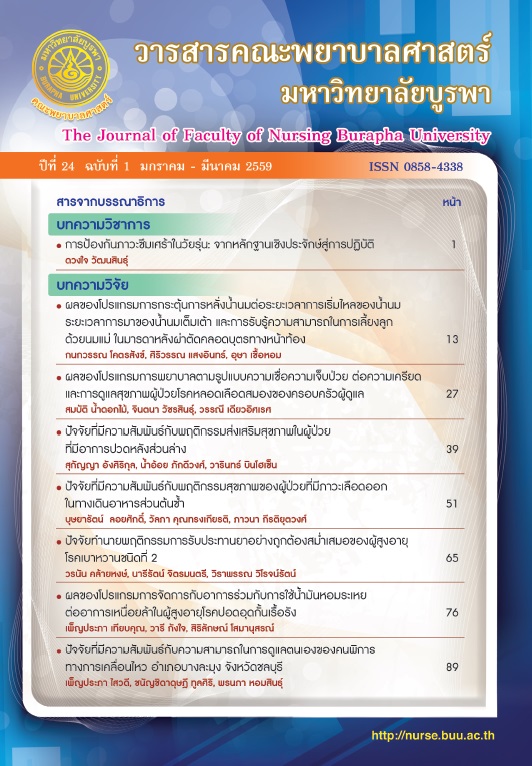ปัจจัยทำนายพฤติกรรมการรับประทานยาอย่างถูกต้องสม่ำเสมอของผู้สูงอายุโรคเบาหวานชนิดที่ 2
คำสำคัญ:
การรับประทานยาอย่างถูกต้องสม่ำเสมอ, ผู้สูงอายุ, โรคเบาหวานชนิดที่ 2, การรับรู้สมรรถนะแห่งตน, การสนับสนุนทางสังคม, Medication adherence, older adults, type 2 diabetes, social support, self-efficacyบทคัดย่อ
บทคัดย่อ
การศึกษาครั้งนี้มีวัตถุประสงค์เพื่อศึกษา พฤติกรรมการรับประทานยาอย่างถูกต้องสม่ำเสมอของผู้สูงอายุโรคเบาหวานชนิดที่ 2 และศึกษาอำนาจการทำนายของ อายุ ระดับการศึกษา รายได้ การรับรู้สมรรถนะแห่งตน การสนับสนุนทางสังคม ต่อพฤติกรรมการรับประทานยาอย่างถูกต้องสม่ำเสมอของผู้สูงอายุโรคเบาหวานชนิดที่ 2 ที่เข้ารับการรักษาในคลินิกเบาหวาน โรงพยาบาลสมเด็จพระบรมราชเทวี ณ ศรีราชา จำนวน 92 ราย เก็บรวบรวมข้อมูลโดยใช้แบบสอบถามข้อมูลส่วนบุคคล การรับรู้สมรรถนะแห่งตน การสนับสนุนทางสังคม พฤติกรรมการรับประทานยาอย่างถูกต้องสม่ำเสมอ วิเคราะห์ข้อมูลโดยใช้สถิติเชิงพรรณนา และการวิเคราะห์การถดถอยพหุคูณแบบขั้นตอน
ผลการศึกษาพบว่า กลุ่มตัวอย่างมีพฤติกรรมการรับประทานยาอย่างถูกต้องสม่ำเสมอระดับดี (X = 22.11, SD = 1.84) ผลการวิเคราะห์การถดถอยพหุคูณแบบขั้นตอน พบว่า อายุ การรับรู้สมรรถนะแห่งตน การสนับสนุนทางสังคม สามารถร่วมกันทำนายพฤติกรรมการรับประทานยาอย่างถูกต้องสม่ำเสมอของผู้สูงอายุโรคเบาหวานชนิดที่ 2 ได้ร้อยละ 48.70 (Adjusted R2 = .487, p < .001) ตัวแปรที่มีอำนาจในการทำนายสูงสุดเรียงตามลำดับ คือ การรับรู้สมรรถนะแห่งตน (β = .519, p < .001) การสนับสนุนทางสังคม (β = .290, p < .001) และอายุ (β = .236, p < .01) ผลการศึกษาครั้งนี้เป็นประโยชน์ต่อการพัฒนาแนวทางการพยาบาลโดยเน้นการส่งเสริมการรับรู้สมรรถนะแห่งตน การสนับสนุนทางสังคมจากบุคลากรทีมสุขภาพ และสมาชิกในครอบครัว เพื่อให้ผู้สูงอายุมีพฤติกรรมการรับประทานยาอย่างถูกต้องสม่ำเสมอ
Abstract
This study was aimed to study medication adherence behaviors among older adults with type 2diabetes and the influence of predicting factors including age, education, income, perceived self-efficacy, and social support, on the medication adherence behaviors among older adults with type 2 diabetes. The sample group consisted of 92 older adults with type 2 diabetes who were treated at the Diabetes Clinic of the Queen Savang Vadhana Memorial Hospital at Sriracha. The data were collected via questionnaires which included personal information, perceived efficacy, social support, and medication adherence behaviors. Data analysis was done using descriptive statistics and stepwise multiple regression analysis.
The results showed that the sample group had a good level of medication adherence behaviors (X = 22.11, SD = 1.84). The results of the stepwise multiple regression analysis found that age, perceived self-efficacy, and social support could predict medication adherence behaviors in older adults with type 2 diabetes by 48.70% (Adjusted R2 = .487, p < .001). The factors with highest influence as a predictive factor were perceived self-efficacy (β = .519, p < .001), followed by social support (β = .290, p < .001), and age (β = .236, p < .01), respectively. The results of this study are beneficial for the development of nursing guidelines, where by focus on enhancing the self-efficacy and promoting social support from health care providers and family members. This would support good medication adherence behaviors in older adults.





